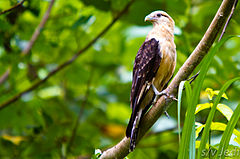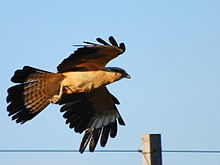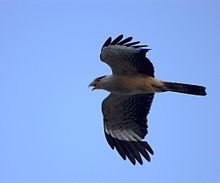- Yellow-headed Caracara
-
Yellow-headed Caracara 
An adult Yellow-headed Caracara in Colon, Panama Conservation status Scientific classification Kingdom: Animalia Phylum: Chordata Class: Aves Order: Falconiformes Family: Falconidae Subfamily: Polyborinae Genus: Milvago Species: M. chimachima Binomial name Milvago chimachima
Vieillot, 1816Synonyms Falco readei Brodkorb, 1959
Milvago readei (Brodkorb, 1959)The Yellow-headed Caracara (Milvago chimachima) is a bird of prey in the family Falconidae. It is found in tropical and subtropical South America and the southern portion of Central America. Unlike the falcons in the same family, the caracara is not a fast-flying aerial hunter, but is rather sluggish and often obtains food by scavenging.
Contents
Description
The Yellow-headed Caracara is 41–46 cm (16–18 in) centimeters in length and weighs 325 g (11.5 oz) on average. Like many other birds of prey,[2] the female is larger than the male, weighing 310–360 g (11–13 oz) against the male's 280–330 g (9.9–12 oz). Apart from the difference in size, there is no significant sexual dimorphism in this species. It is broad-winged and long-tailed, somewhat resembling a small Buteo. The adult has a buff head, with a black streak behind the eye, and buff underparts. The upper plumage is brown with distinctive pale patches on the flight feathers of the wings, and the tail is barred cream and brown. The head and underparts of immature birds have dense brown mottling.
The voice is a characteristic screamed schreee.
Taxonomy and systematics
Distribution and habitat
This is a bird of savanna, swamps and forest edges. The Yellow-headed Caracara is a resident bird from Costa Rica south through Trinidad and Tobago to northern Argentina (the provinces of Misiones, Chaco, Formosa, Corrientes and Santa Fe). It is typically found from sea level to 1,800 m (5,900 ft), occasionally to 2,600 m (8,500 ft) above mean sea level. In southern South America, it is replaced by a close relative, the Chimango Caracara (Milvago chimango), whose range overlaps with that of the Yellow-headed Caracara in southern Brazil, northern Argentina, Paraguay and Uruguay. A larger and stouter paleosubspecies, Milvago chimachima readei, occurred in Florida and possibly elsewhere some tens of thousand years ago, during the Late Pleistocene.[3] According to the Peregrine Fund database, the Yellow-headed Caracara is expanding its range into Nicaragua.[4]
Behavior and ecology
The Yellow-headed Caracara is omnivorous, and will eat reptiles, amphibians and other small animals as well as carrion. Birds are rarely if ever taken, and this species will not elicit warning calls from mixed-species feeding flocks that cross its path even in open cerrado habitat .[5] It will also take ticks from cattle, and is locally called "tickbird". In addition, at least younger birds are fond of certain fruits, such as those of the Oil palm (Elaeis guineensis) and Pequi (Caryocar brasiliense).[6] It lays from five to seven brown-marked buff eggs in a stick nest in a tree.[7]
The Yellow-headed Caracara has benefited from forest clearing for cattle ranching. Its status in Trinidad has changed from rare to fairly common, and it was first seen on Tobago in 1987.[8] It adapts readily to urban areas and, together with species such as the American Black Vulture (Coragyps atratus), it is among the most commonly seen bird of prey in Latin American cities. Consequently, this wide-ranging species has been assigned a risk level of Least Concern category on the IUCN Red List.[1] In Panama City for example, as a result of the increased urban sprawl, Yellow-headed Caracara pairs are frequently seen along the rooftops in suburban neighborhoods.
Footnotes
- ^ a b "Milvago chimachima". IUCN Red List of Threatened Species. Version 2011.1. International Union for Conservation of Nature. 2009. http://www.iucnredlist.org/apps/redlist/details/144530. Retrieved 2011-07-15.
- ^ Andersson, MB (1994). Sexual selection. Princeton, New Jersey: Princeton University Press. p. 269. ISBN 978-0-691-00057-2. http://books.google.com/books?id=lNnHdvzBlTYC.
- ^ Emslie, SD (1998). "Avian Community, Climate, and Sea-Level Changes in the Plio-Pleistocene of the Florida Peninsula". Ornithological Monographs 50: 44–5. http://elibrary.unm.edu/sora/om/om050.pdf.
- ^ "Milvago chimachima". Global Raptor Information Network. The Peregrine Fund. http://www.globalraptors.org/grin/SpeciesLookup.asp. Retrieved 2011-07-15.
- ^ Ragusa-Netto, J (2000). "Raptors and "campo-cerrado" bird mixed flock led by Cypsnagra hirundinacea (Emberizidae: Thraupinae)" (in English with Portuguese abstract). Revista Brasileira de Biologia 60 (3): 461–7. doi:10.1590/S0034-71082000000300011. http://www.scielo.br/pdf/rbbio/v60n3/3933.pdf. Retrieved 2011-07-15.
- ^ Olmos et al. (2006)
- ^ Pereira (2008) page 45
- ^ French et al. (1991)
References
- ffrench, Richard; O'Neill, John Patton & Eckelberry, Don R. (1991): A guide to the birds of Trinidad and Tobago (2nd edition). Comstock Publishing, Ithaca, N.Y.. ISBN 0-8014-9792-2
- Hilty, Steven L. (2003): Birds of Venezuela. Christopher Helm, London. ISBN 0-7136-6418-5
- Olmos, Fábio; Pacheco, José Fernando & Silveira, Luís Fábio (2006): Notas sobre aves de rapina (Cathartidae, Acciptridae e Falconidae) brasileiras [Notes on Brazilian birds of prey]. Revista Brasileira de Ornitologia 14(4): 401-404 [Portuguese with English abstract]. PDF fulltext
- Pereira, José Felipe Monteiro (2008) : Aves e Pássaros Comuns do Rio de Janeiro(Common birds of Rio de Janeiro). Rio de Janeiro, Technical Books, ISBN 978-85-61368-00-5
External links
- Yellow-headed Caracara videos on the Internet Bird Collection
- Yellow-headed Caracara photo gallery VIREO
- Photo-High Res
!--see a good RangeMap/maps, lists, etc. at: "www.natureserve.org"(then 'InfoNatura')....only category shown for the species: "Permanent Resident"-->
Categories:- IUCN Red List least concern species
- Milvago
- Caracaras
- Animals described in 1816
- Birds of South America
- Birds of the Amazon Basin
- Birds of the Guianas
- Birds of Marajó Island
- Birds of the Cerrado
- Birds of the Caatinga
- Birds of the Pantanal
- Birds of Trinidad and Tobago
- Birds of Costa Rica
- Birds of Panama
Wikimedia Foundation. 2010.



